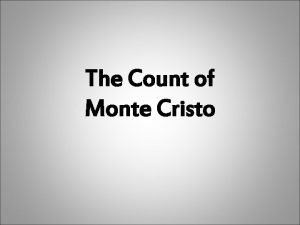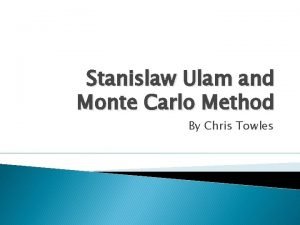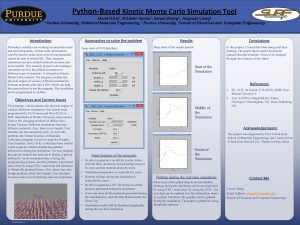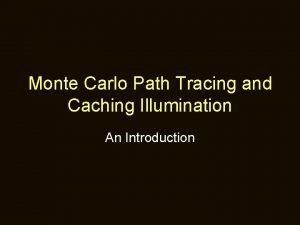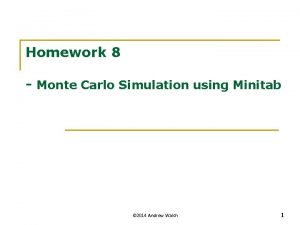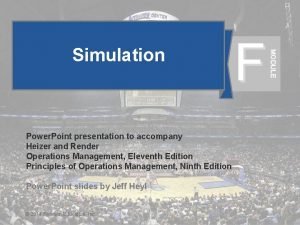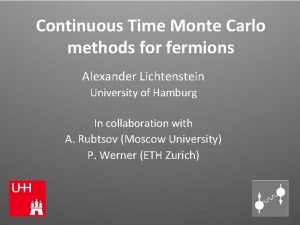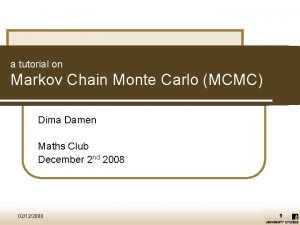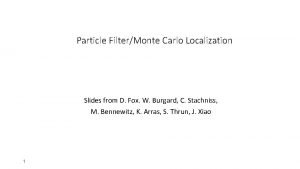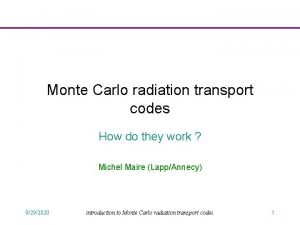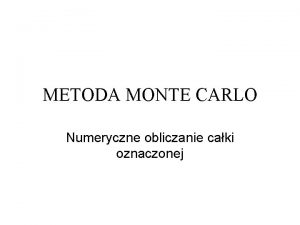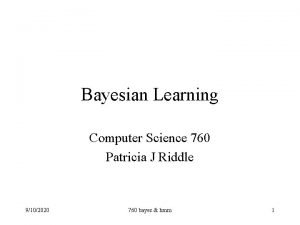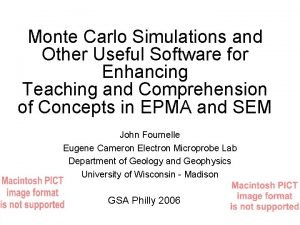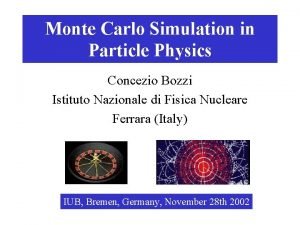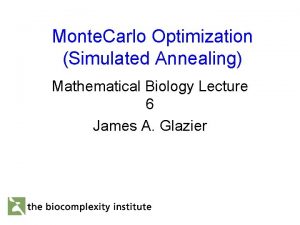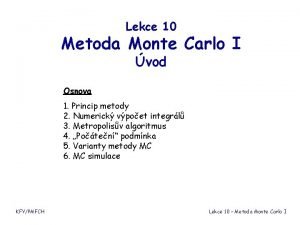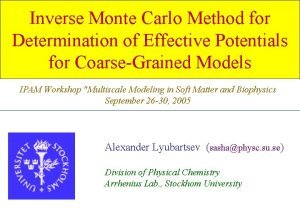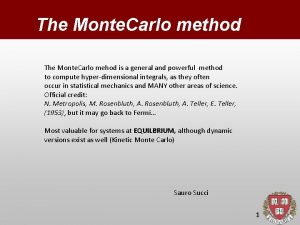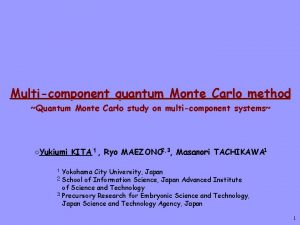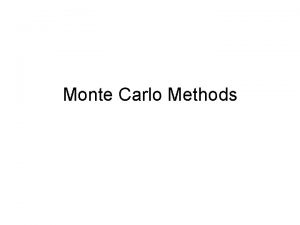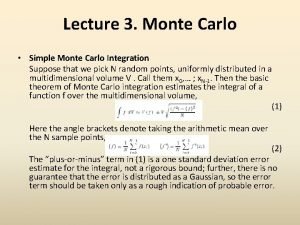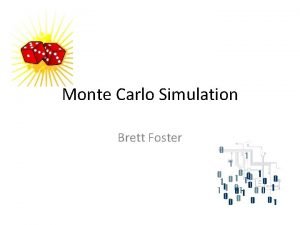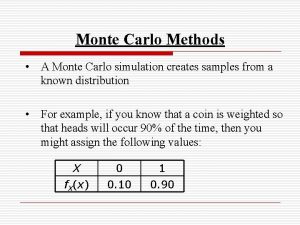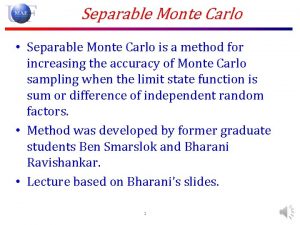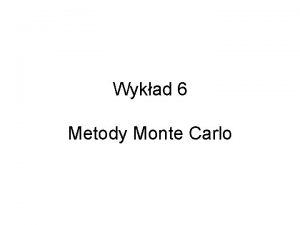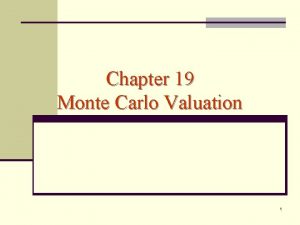The Monte Carlo method for the solution of









![Flight duration P[k(t)]dt is the probability that a carrier in the state k suffers Flight duration P[k(t)]dt is the probability that a carrier in the state k suffers](https://slidetodoc.com/presentation_image_h/74d0bd3c9f314d324db88e0aa38141fd/image-10.jpg)












- Slides: 22

The Monte Carlo method for the solution of charge transport in semiconductors R 96941064 洪于晟

Abstract With the Monte Carlo method, we apply this method to solutions of transport problems in conductors. The presentation will put attentions on the evaluations of the integrated scattering probabilities. For their direct use. A collection of results obtained with Monte Carlo simulations will be presented.

Information Flowchart of a typical Monte Carlo program. Basic formula Definition of the physical system Initial conditions of motion What’s assumption in application? Flight duration Self-scattering What’s the random number? Simulation results Within sophisticated theorem

Information Flowchart of a typical Monte Carlo program. Basic formula Definition of the physical system Initial conditions of motion What’s assumption in application? Flight duration Self-scattering What’s the random number? Simulation results Within sophisticated theorem

Flowchart of a typical Monte Carlo program

Basic formula During each collision (each new flight), the relation of external force of carrier in semiconductor is From the differential cross section of this mechanism, a new k state after scattering is randomly chosen as initial state of the new free flight.

Definition of the physical system The parameters that characterize the material, the least known, usually taken as adjustable parameters. We also define the parameters that control the simulation, such as the duration of each subhistory, the desired precision of the results, and so on.

Initial conditions of motion For the information of stationary, homogeneous, transport process, the time of simulation must be long enough. In order to avoid the undesirable effects of an inappropriate initial choice and to obtain a better convergence, the simulation is divided into many subhistories.

Information Flowchart of a typical Monte Carlo program. Basic formula Definition of the physical system Initial conditions of motion What’s assumption in application? Flight duration Self-scattering What’s the random number? Simulation results Within sophisticated theorem
![Flight duration Pktdt is the probability that a carrier in the state k suffers Flight duration P[k(t)]dt is the probability that a carrier in the state k suffers](https://slidetodoc.com/presentation_image_h/74d0bd3c9f314d324db88e0aa38141fd/image-10.jpg)
Flight duration P[k(t)]dt is the probability that a carrier in the state k suffers a collision during the time dt. Assume the probability that has no suffered another collision is Y(t)

Flight duration t ↑, collision events↑, Y(t) ↓. Thus, Y= The probability P(t) that the carrier will suffer its next collision during dt is P(t)dt =

But, what’s the problem ? The problem is: the integral for the collision of this situation is too complex.

self-scattering Rees (1968, 1969) has devised a very simple method to overcome this difficulty. If Γ ≡ 1/ τ0 is the maximum value of P(k) in the region of k space.

self-scattering A new fictitious “self-scattering” is introduced. If carrier undergoes such a self-scattering, it state k’ after the collision is taken to be equal to its state k before collision. It means ‘”as if no scattering at all had occurred” Generally, it is sufficient that Γ can be not less than the maximum value of P(k).

self-scattering P(t) = With the constant P(k) = Γ = 1/ τ0 The probability P(t) is approximate as diffusion

Information Flowchart of a typical Monte Carlo program. Basic formula Definition of the physical system Initial conditions of motion What’s assumption in application? Flight duration Self-scattering What’s the random number? Simulation results Within sophisticated theorem

What’s the random number 0 ≦ P(t) τ0 = exp(-t/ τ0 ) ≦ 1 Set the random number r = P(t) τ0 , 0≦r≦ 1 Thus, the time t between each collision is t = - τ0 ln(r)

Information Flowchart of a typical Monte Carlo program. Basic formula Definition of the physical system Initial conditions of motion What’s assumption in application? Flight duration Self-scattering What’s the random number? Simulation results Within sophisticated theorem

Sampling particle

Within sophisticated theorem

Reference Rev. Mod. Phys. 55, 645 - 705 (1983) Carlo Jacoboni and Lino Reggiani Gruppo Nazionale di Struttura della Materia, Istituto di Fisica dell'Università di Modena, Via Campi 213/A, 41100 Modena Italy

Thanks for your attention Wish you have a good summer vacation
 Monte carlo simulation matlab
Monte carlo simulation matlab Count of monte carlo
Count of monte carlo Stanislaw ulam
Stanislaw ulam Contoh simulasi monte carlo
Contoh simulasi monte carlo Mnemstudio
Mnemstudio Kinetic monte carlo python
Kinetic monte carlo python Monte carlo tree search tutorial
Monte carlo tree search tutorial Monte carlo path tracing
Monte carlo path tracing Monte carlo localization for mobile robots
Monte carlo localization for mobile robots Monte carlo simulation minitab 19
Monte carlo simulation minitab 19 Monte carlo simulation advantages and disadvantages ppt
Monte carlo simulation advantages and disadvantages ppt Continuous time monte carlo
Continuous time monte carlo Markov chain monte carlo tutorial
Markov chain monte carlo tutorial Monte carlo localization python
Monte carlo localization python Monte carlo radiation transport
Monte carlo radiation transport Metoda monte carlo algorytm
Metoda monte carlo algorytm Viterbi algorithm
Viterbi algorithm Monte carlo search tree
Monte carlo search tree Monte carlo simulation freeware
Monte carlo simulation freeware Concezio bozzi
Concezio bozzi Monte carlo optimization
Monte carlo optimization Metoda monte carlo
Metoda monte carlo Inverse monte carlo
Inverse monte carlo

